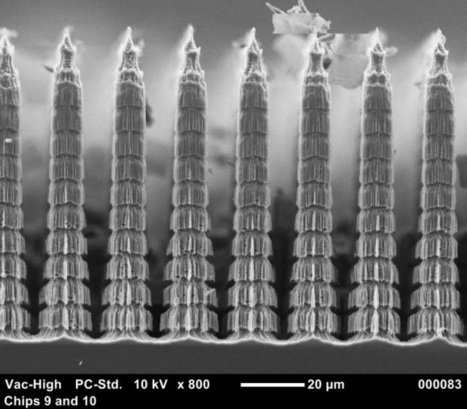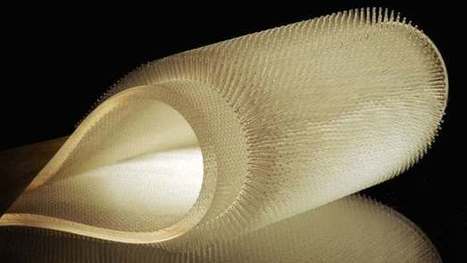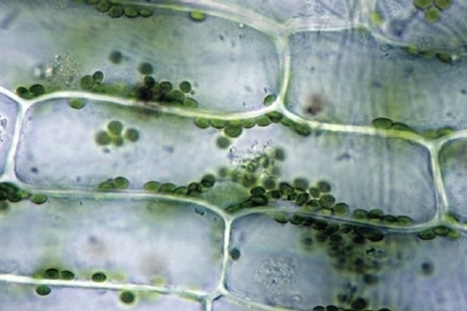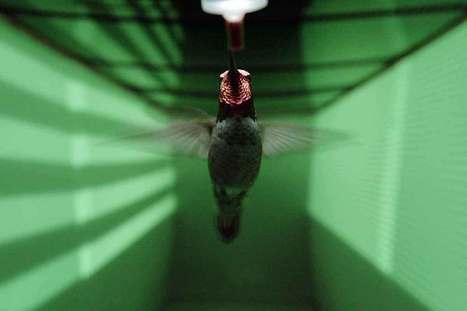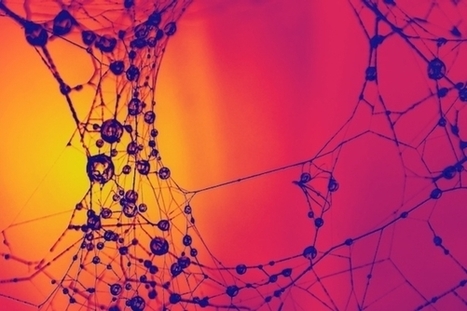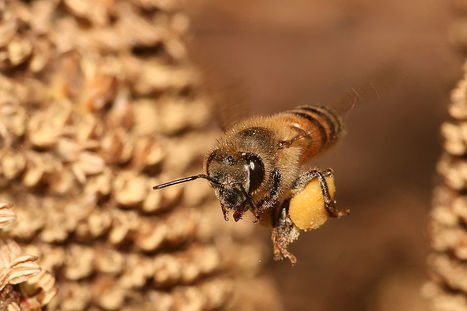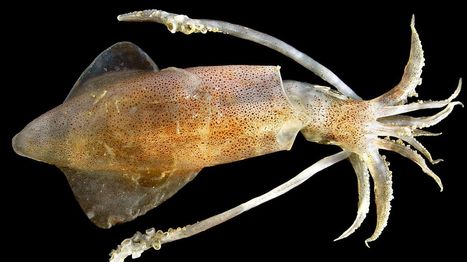 Your new post is loading...
 Your new post is loading...
"Wind turbines produce 4% of the planet’s energy, but they only work well when the wind is blowing just right. Now, by drawing inspiration from the flexible wings of insects, scientists have found a way to make wind turbine blades 35% more efficient at producing energy. If commercialized, the advance could make this green technology a more viable alternative to fossil fuels in the coming years."
"If you wanted to see in the dark, you could do worse than follow the example of moths, which have of course made something of a specialty of it. That, at least, is what NASA researchers did when designing a powerful new camera that will capture the faintest features in the galaxy."
Scientists have developed a new prototype battery inspired by the anatomy of the human intestine, and the biologically informed approach could pave the way for much more powerful energy sources for our digital devices.
The prototype – which offers up to five times the energy density of the lithium-ion batteries we use in smartphones and laptops – uses a lithium-sulphur cell instead, and its intestine-mimicking design could finally make these energy-dense batteries long-lasting enough for commercial use.
(San Rafael, CA – October 22, 2016) A team from the Ceres Regional Center for Fruit and Vegetable Innovation in Chile has won the first-ever $100,000 Ray C. Anderson Foundation “Ray of Hope” Prize in the Biomimicry Global Design Challenge, an international design competition and accelerator program that crowdsources nature-inspired solutions to big sustainability challenges, such as climate change, food system issues, water management, and alternative energy. Approximately 25 percent of the world’s soil is degraded, and the winning concept provides a new way to protect seedlings and restore soils back to health.
Even though they don't have a thick layer of blubber, animals such as beavers and sea otters are still able to stay warm when diving in frigid waters. How do they do it? Well, they trap an insulating layer of air between the hairs of their fur. MIT scientists have taken that concept and run with it (or swum with it), creating a bioinspired material that could be used to make lighter, warmer wetsuits.
Like all injection molding processes, HARBEC heats solid plastic until it liquefies, presses the molten plastic into the cavity of a mold, and waits for the part to cool before ejecting it. This series of steps—melt, press, cool, eject—is called a cycle. When thousands or even millions of parts are being manufactured for a customer, the duration of each cycle is critical, and HARBEC knew that the cooling step was adding up to significant time and energy costs.
The project focused on the challenge of decreasing the time and energy spent during the cooling phase of the injection molding process. Turning to the many cooling systems in nature for inspiration, Terrapin worked with HARBEC’s engineering and manufacturing teams as well as topical experts from our network to innovate on current designs. After abstracting the underlying principles of the fluid-carrying channels in certain leaves, the project team combined these insights with the capabilities of additive manufacturing. The result is a design that reduces the time and energy used by more than 20% compared to conventional solutions. Read the case study for the full account of how we unlocked these significant energy and time savings!
"Extending the limit of the classical microscope's resolution has been the holy grail of microscopy for over a century. Physical laws of light make it impossible to view objects smaller than 200nm – the smallest size of bacteria – using a normal microscope alone. However, superlenses that enable us to see beyond the current magnification have been the goal since the turn of the millennium.
After a team at Bangor University's School of Electronic Engineering used a nanobead-derived superlens to break the perceived resolution barrier, the same team has achieved another world first. The team, led by Dr Zengbo Wang, and in colloboration with Professor Fritz Vollrath's silk group at Oxford University's Department of Zoology, has used a naturally occurring material – dragline silk of the golden web spider – as an additional superlens, applied to the surface of the material to be viewed, that provides an additional 2-3 times magnification. This is the first time that a naturally occurring biological material has been used as a superlens."
"It only takes a brief journey down a B road during the summer months to end up with a car looking like it has driven through a plague of insects. Amplify this effect by the power of a space shuttle wingspan and bug remnants can result in a significant increase in drag. The problem is that when an insect hits an aircraft at speed its mass ruptures and undergoes some chemical changes which make it stickier. Flying through a swarm of insects leads to an accumulation of debris on the leading edge of wings which creates drag and increases fuel consumption. NASA researchers, in collaboration with engineers at Langley and Boeing, studied the microscopically-rough texture of lotus leaves in order to understand how the surface is so effective at repelling dirt, dust and water."
"Some water ferns can absorb large volumes of oil within a short time, because their leaves are strongly water-repellent and, at the same time, highly oil-absorbing. Researchers of KIT, together with colleagues of Bonn University, have found tha the oil-binding capacity of the water plant results from the hairy microstructure of its leaves. It is now used as a model to further develop the new Nanofur material for the environmentally friendly cleanup of oil spills."
A tree's leaf, a blade of grass, a single algal cell: all make fuel from the simple combination of water, sunlight and carbon dioxide through photosynthesis. Now scientists say they have replicated—and improved on—that trick with their own “bionic leaf.”
Photo details: Tokay gecko by Aparajita Datta (Own work) [CC BY-SA 3.0], via Wikimedia Commons
Scientists in China have designed a smart material that rapidly switches from one shape to anotherjust like a Venus flytrap plant snaps close when trapping prey.
Inspired by carnivorous plant’s movement, researchers have been designing polymers that rapidly change shape in response to external stimuli. However, the snapping process is usually irreversible, which has so far limited the materials’ practical potential.
"Hummingbirds have a unique collision avoidance system built into their brains that allows them to perform high-speed aerobatics in safety. The super-agile birds, whose wings beat up to 70 times a second, can hover, fly backwards, and whizz through dense vegetation at more than 50 kilometres per hour. How they manage to avoid potentially fatal crashes has remained a mystery until now. Researchers in Canada conducted a series of experiments which showed that the birds process visual information differently from other animals. As they dart and dive at speed, they judge distance from the way looming objects appear to get bigger, and vice versa."
|
"If you ever find yourself watching hedgehog go about its day, you’ll notice that they tend to fall out of trees — a lot. Wild hedgehogs climb trees as high as 30 feet, looking for insects and food to eat. Sometimes they fall by accident, other times they fall on purpose to evade a predator or because falling is a lot faster than climbing down. As a hedgehog falls toward the ground, it keeps itself safe by rolling into a ball to surround itself with “spines” that absorb the impact. (Hedgehog spines are colloquially referred to as “quills,” which is the official term for what porcupines have. Hedgehog spines function differently, however, than porcupine quills.) It’s an effective method of protection — and one that humans want to steal."
"Many species of owl are able to hunt in effective silence by suppressing their noise at sound frequencies above 1.6 kilohertz (kHz) - over the range that can be heard by humans.
A team of researchers studying the acoustics of owl flight—including Justin W. Jaworski, assistant professor of mechanical engineering and mechanics at Lehigh University—is working to pinpoint the mechanisms that accomplish this virtual silence in order to improve the aerodynamic design of wind turbines, aircraft, naval ships and even automobiles. Now, the team has succeeded—through physical experiments and theoretical modeling—in using the downy canopy of owl feathers as a model to inspire the design of a 3D-printed, wing attachment that reduces wind turbine noise by 10 decibels without impacting aerodynamics."
"[The new] 454’s wheels feature a lumpy rim profile, called SawTooth, that Zipp claims delivers unrivaled stability in crosswinds while also improving aerodynamics. For the 454, Zipp looked to humpback whales and, specifically, the lumps on the leading edges of their pectoral fins. Called tubercles, these protrusions make humpbacks more agile by keeping water attached to their flippers when they turn. In the same way that a plane can stall when air separates from the wing during high-speed maneuvers, uncontrolled turbulence over a whale’s flipper makes turning more difficult. Tubercles keep the water attached as it flows past. Zipp says its SawTooth tubercles, which the company calls “Hyperfoils,” make deep-section rims more stable in crosswinds by forcing air to slip around and off the rims in a much more predictable manner.
"A brain-inspired computing component provides the most faithful emulation yet of connections among neurons in the human brain, researchers say. The so-called memristor, an electrical component whose resistance relies on how much charge has passed through it in the past, mimics the way calcium ions behave at the junction between two neurons in the human brain, the study said. That junction is known as a synapse. The researchers said the new device could lead to significant advances in brain-inspired—or neuromorphic—computers, which could be much better at perceptual and learning tasks than traditional computers, as well as far more energy efficient."
"If you take a close look at a leaf from a tree and you’ll notice the veins that run through it. The structure these veins take are what’s called a quasi-fractal hierarchical networks. Fractals are geometric shapes in which each part has the same statistical character of the whole. Fractal science is used to model everything from snowflakes and the veins of leaves to crystal growth. Now an international team of researchers led by Helmholtz-Zentrum Berlin have mimicked leaves’ quasi-fractal structure and used it to create a network of nanowires for solar cells and touch screen displays."
"The team of architects Maryan Fazel and Belinda Ercan, from Iran and Germany, respectively, have won first prize in the competition for the design of the Moscow Circus School launched by the Architectural Competition Concours d’Architecture (AC-CA).
The winning proposal, entitled Elytra, is an “eye-catching, cutting-edge, [and] unconventional” design that will tower over Moscow’s Tverskoy District, an area which features a burgeoning artistic scene. Inspired by the forewings of insects—called elytra—the project opens upwards as a protective shell, and will feature both public and private space."
"Spider silk is well-known for its unusual combination of being both lightweight and extremely strong—in some cases, stronger than steel. Due to these properties, researchers have been developing spider-silk-inspired materials for potential applications such as durable yet lightweight clothing, bullet-proof vests, and parachutes. But so far, the acoustic properties of spider webs have not yet been explored. Now in a new study, a team of researchers from Italy, France and the UK has designed an acoustic metamaterial (which is a material made of periodically repeating structures) influenced by the intricate spider web architecture of the golden silk orb-weaver, also called the Nephila spider."
Photo details: An orb-weaving spider (Nephila clavipes), by Ianaré Sévi [CC BY 3.0], via Wikimedia Commons.
"Spend a summer in the countryside in a warm climate and you’ll likely hear crickets chirping, males of the species “singing” in an attempt to attract a female. What’s surprising is how small the creatures are given the very high sound levels they produce. Could studying crickets allow us to learn something about how to design a small speaker that is also loud, just as you need for a hearing aid?"
"For a delivery truck making rounds, minor tweaks in a route can save huge amounts of time and gas. That's why UPS spent a decade and hundreds of millions of dollars building an algorithm to help calculate where trucks should turn. A startup called Routific designed an algorithm to help everyone else—like local flower delivery companies—also save fuel. To help find the best routes, they took inspiration from bees. Their algorithm is based on the "bees algorithm," which describes how bees find the best route to flowers. Scout bees fly long distances in random directions, and if they find food, they fly back and buzz around in the so-called "waggle dance" to notify everyone else. When others go to the same location, they'll come back and waggle even harder if they find a better spot."
Photo details: Apis mellifera by Muhammad Mahdi Karim (www.micro2macro.net) Facebook Youtube), GFDL 1.2, via Wikimedia Commons
Taking a clue from jellyfish and squids that quickly alter their appearance via muscle-controlled morphology changes in their bodies’ surface structures, researchers have designed polymeric materials that change appearance reversibly in response to mechanically induced folds and deformations
"IBM scientists have created randomly spiking neurons using phase-change materials to store and process data. This demonstration marks a significant step forward in the development of energy-efficient, ultra-dense integrated neuromorphic technologies for applications in cognitive computing. Inspired by the way the biological brain functions, scientists have theorized for decades that it should be possible to imitate the versatile computational capabilities of large populations of neurons. However, doing so at densities and with a power budget that would be comparable to those seen in biology has been a significant challenge, until now."
2Protective clothing is critical to the health and safety of workers who handle hazardous chemicals. A new fabric coating promises to not only neutralize toxins, but also to heal tears and holes on its own while the clothes go through the laundry. The coating, developed by a team of researchers from Penn State and Drexel University, is derived from proteins that make up the rings of teeth on squid suckers."
|





 Your new post is loading...
Your new post is loading...


